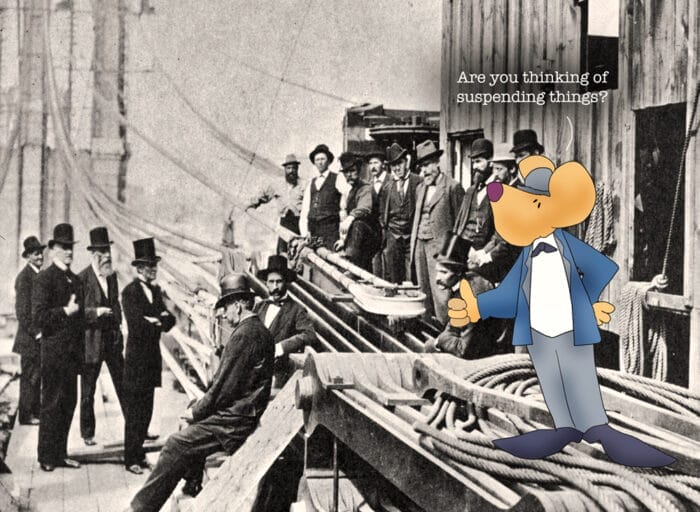I’m not sure if I’ve ever been on the Brooklyn Bridge. I’ve been to New York on a few occasions and been driven around by some madcap taxi drivers, who could have very well taken me across the thing, and I would have never known it. To me, riding in a taxi in New York deserves some sort of medal of bravery. I keep my eyes closed most of the time.
Anyway, the Brooklyn Bridge. It celebrates a birthday. It was opened in the year 1883 on this very date. It is, by far, the most famous way to get over the East River.
But its beginnings were a little on the shady side. The guy hired by the NY Bridge Company, to build his “concept” of a suspension bridge, was named John Augustus Roebling. He was a Prussian-born engineer, a failed farmer, I might add. But with the bridge, somewhere along the line, the project met with resistance. So that famous NY Politico, Boss Tweed, pushed a bribe under the table. He “funneled $65,000 in bribes to city aldermen to secure funding for the bridge.” (History Channel)
There seemed to be some bad luck swirling about it too. The guy, the engineer, that John Roebling? He was taking measurements for it one day, and a ferry came along and crushed his foot. Roebling developed tetanus from those wounds, and he died in July of 1869. He never saw the bridge open.
But. His son took over as the chief engineer. And then he fell on some bad luck too. The son’s name was Washington Augustus Roebling. I never knew this, but to build the massive foundation of the bridge, the workers had to be down there in “caissons” which were sealed chambers, filled with compressed air. The chambers kept the riverbed dry and allowed for digging. Well, working in those caissons was very dangerous. That compressed air can have its problems, specifically “caisson disease” which is better known as the bends. Washington Roebling came down with this decompression sickness and was indefinitely confined to bed. Paralyzed for life. Not only was Roebling injured, but some 25 other workers were also killed during the construction of that bridge.
But then, another Roebling stepped in. This time it was Emily Warren Roebling, the wife of bendy Washington. She rolled up her sleeves and took command of the project. Did it all too — overseeing the design, construction, and business management. It was a big dang undertaking.
“Emily Warren Roebling is now widely recognized as a pioneering female engineer and a driving force behind the bridge. Following her work on the bridge, Emily went on to earn a degree in law from New York University and published essays in favor of gender equality.” (History Channel)
Emily was the first human across the bridge. A bit of a ceremonial opening. She took a carriage over the bridge, with, WITH, a rooster in her lap, for good luck. All of this as President Arthur Chester looked on from the audience.
Yes, President Arther Chester was there to “open” the bridge, with the Governor of New York, Grover Cleveland. Chester didn’t have too much going in the way of a Presidency, other than the Pendleton Civil Service Act. It was landmark legislation. It mandated that certain federal government jobs be distributed based on merit, rather than political connections. A good thing Chet. Along with the champagne cracking at the bridge.
That bridge. Still today. Stands tall and proud, despite having been “sold” so many times before. Yes, there lived a dubious conman George C. Parker, in the early 1900s. He would sell the Brooklyn Bridge, and other NY Landmarks, to unwary immigrants. He did this so many times, that he owned four mansions as a result. Certain of those poor immigrants had to be moved off the bridge by law officers at times, after they tried to construct toll booths there. Eventually, though, Parker found his way to a life sentence in Sing Sing.
So today, I don’t have any bridge to sell you.
Just a story. Or maybe even a song. One that I can Sing, Sing.
Just like a bridge, over troubled waters. Yeah.
============
“Men build too many walls and not enough bridges.”
― Joseph Fort Newton
===========
“Don’t burn your bridges.”
— Unknown
===========
“Let’s cross that bridge when we come to it.”
— Unknown
==========
Bridge, not the card game. The crossing kind.
